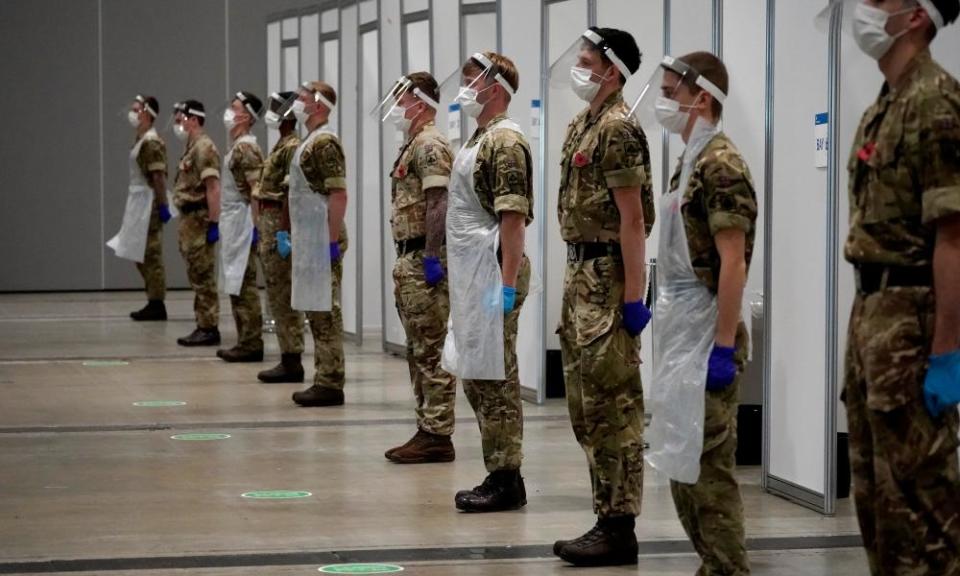Tale of two cities: the Covid paths of Liverpool and Manchester defined by Westminster

As Matt Hancock put the final touches to England’s new lockdown regime on Wednesday night the mood of leaders in Manchester compared with those in Liverpool could not have been more different.
On Merseyside the leaders felt they had done all they could to have become the first English region to leave the strictest coronavirus measures introduced six weeks ago. The Liverpool City region has now been moved down to tier 2.
Across the M62, the Greater Manchester mayor, Andy Burnham, grimly expected yet another dose of punishment for 2.8 million people who have been unable to see others indoors for a period of four months. Manchester was put back into tier 3.
The confirmation, when it came, told a tale of two cities that have each suffered a shocking human toll from Covid-19 but have emerged with contrasting fortunes from their dealings with Westminster.
Liverpool has become the unlikely poster child of the government’s coronavirus strategy, while Manchester is trapped in never-ending lockdown.
There are two ways to view the decision to keep Manchester in the harshest restrictions while relaxing the rules in Liverpool.
The more cynical view is that it is payback for Burnham’s refusal to accept tier 3 rules without sufficient financial support in October, which so clearly infuriated ministers. But hardly any senior figures in Greater Manchester see it this way.
“I don’t buy the punishment angle. Why are Lancashire in tier 3 if that’s the case? Probably more to do with our figures being worse than Liverpool and over a longer period of times,” said one.
A more clear-eyed view is that, while Greater Manchester’s infection rate is falling faster than any other part of England, it remains in a more difficult position than Liverpool. The numbers of cases among older people, in particular, is significantly higher there than in the rest of the country and there is therefore more risk of overwhelming an already strained NHS.
How both cities came to be in their situation does relate in part to the political decisions made in the crucial month of October.
The two Liverpool leaders – Joe Anderson, the city mayor, and Steve Rotheram, the metro mayor of the wider region – made no secret of their willingness to enter the tightest restrictions as soon as they were introduced on 14 October.
At that point, Liverpool and neighbouring Knowsley were the worst-hit areas of England with an infection rate 14 times that of London and quadruple the national average. Older people were catching the virus at a terrifying speed: the proportion of over-80s testing positive rose 100-fold, to 527 cases per 100,000 people, over six weeks to the beginning of October.
The city’s three main hospitals were taking in many Covid patients, reaching 85% capacity and treating more sick people by the end of October than they had been during their busiest period in the spring. They were so close to being overwhelmed that seriously ill patients were nearly rushed 40 miles along the motorway to Manchester’s Nightingale hospital.
Faced with an overwhelmed NHS, Liverpool leaders felt they had no alternative but to accept tier 3 restrictions.
In Manchester the second wave did not yet threaten to overwhelm hospitals, giving Burnham and his 10 council leaders more leeway to challenge the government.
At every opportunity, Boris Johnson and his ministers delighted in thanking Rotheram, a former Jeremy Corbyn aide, for his cooperation in contrast to his friend over the M62. It played badly in both Liverpool and Manchester. “He keeps being thrown under a Boris bus,” said one Liverpool adviser, while Burnham accused ministers of playing divide and rule with the regions.
Over the Halloween weekend Anderson and Hancock signed off an ambitious programme for Liverpool to host the UK’s first city-wide mass-testing pilot, which began on 6 November. By Thursday lunchtime one in three Liverpool residents had been tested under the programme, including 703 Covid-positive people who had no symptoms and would not otherwise have been tested and gone into self isolation.
The mass-testing scheme, which has raised eyebrows among some in the scientific community, has provably helped Liverpool’s infection rate fall by two-thirds from its height six weeks ago, said Matt Ashton, the city’s director of public health.
Ashton said: “It has massively raised awareness of Covid in the city. I know that sounds ridiculous – how can anyone not know? – but the reality is that this is more present in some people’s lives than it is in others. The big challenge is keeping the infection rate down. We’ve won this battle but we haven’t won the war yet. We’ve got a long winter ahead of us.”

